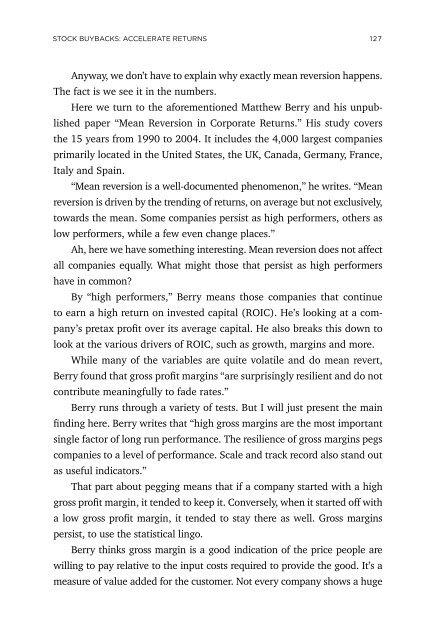You also want an ePaper? Increase the reach of your titles
YUMPU automatically turns print PDFs into web optimized ePapers that Google loves.
STOCK BUYBACKS: ACCELERATE RETURNS 127<br />
Anyway, we don’t have to explain why exactly mean reversion happens.<br />
The fact is we see it in the numbers.<br />
Here we turn to the aforementioned Matthew Berry and his unpublished<br />
paper “Mean Reversion in Corporate Returns.” His study covers<br />
the 15 years from 1990 to 2004. It includes the 4,000 largest companies<br />
primarily located in the United States, the UK, Canada, Germany, France,<br />
Italy and Spain.<br />
“Mean reversion is a well-documented phenomenon,” he writes. “Mean<br />
reversion is driven by the trending of returns, on average but not exclusively,<br />
towards the mean. Some companies persist as high performers, others as<br />
low performers, while a few even change places.”<br />
Ah, here we have something interesting. Mean reversion does not affect<br />
all companies equally. What might those that persist as high performers<br />
have in common?<br />
By “high performers,” Berry means those companies that continue<br />
to earn a high return on invested capital (ROIC). He’s looking at a company’s<br />
pretax profit over its average capital. He also breaks this down to<br />
look at the various drivers of ROIC, such as growth, margins and more.<br />
While many of the variables are quite volatile and do mean revert,<br />
Berry found that gross profit margins “are surprisingly resilient and do not<br />
contribute meaningfully to fade rates.”<br />
Berry runs through a variety of tests. But I will just present the main<br />
finding here. Berry writes that “high gross margins are the most important<br />
single factor of long run performance. The resilience of gross margins pegs<br />
companies to a level of performance. Scale and track record also stand out<br />
as useful indicators.”<br />
That part about pegging means that if a company started with a high<br />
gross profit margin, it tended to keep it. Conversely, when it started off with<br />
a low gross profit margin, it tended to stay there as well. Gross margins<br />
persist, to use the statistical lingo.<br />
Berry thinks gross margin is a good indication of the price people are<br />
willing to pay relative to the input costs required to provide the good. It’s a<br />
measure of value added for the customer. Not every company shows a huge


